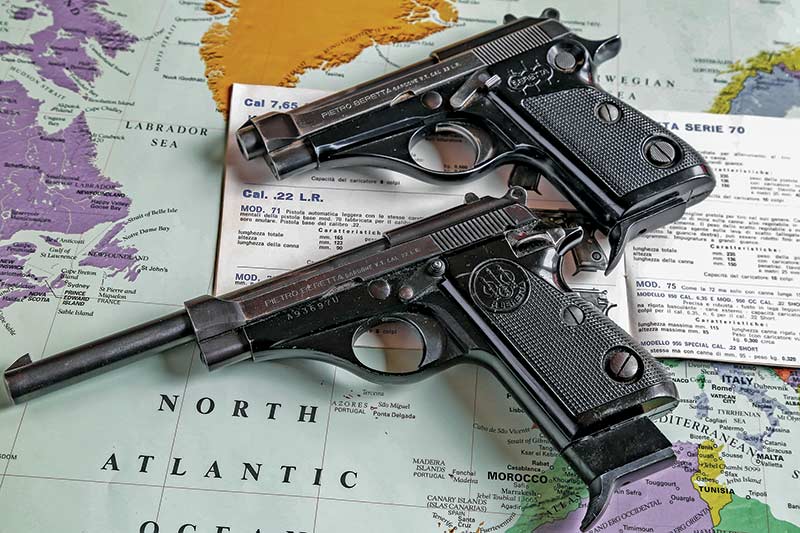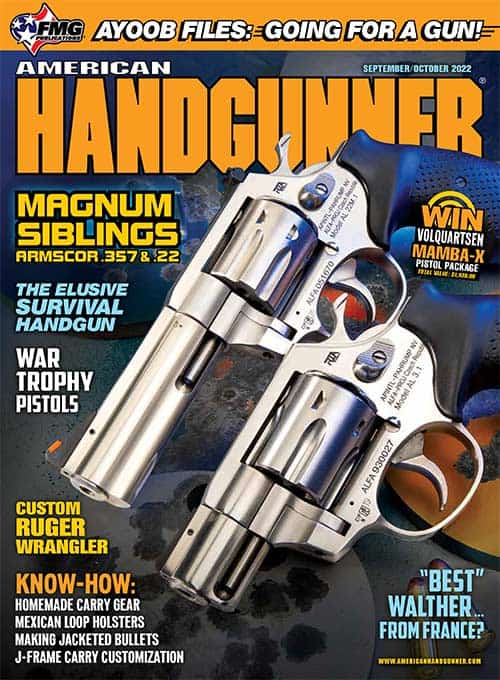Better Shooting: Beretta’s
Classic Pocket .22s
Pocket automatics chambered for .22LR have the same utility as the compact S&W “Kit Guns.” They are guns to keep handy while camping, hiking, fishing, big game hunting, or doing routine outdoor work on a farm or ranch. They are useful for pest control, small game hunting and targets of opportunity one comes across in routine outdoor activities.
70 Series: Cult Classic
More than 50 years ago, the first handgun I ever purchased was a Beretta Model 71. The Beretta 70 series was in production from 1958 to 1985. Initially made in 7.65mm (.32 ACP), a .22LR version soon followed. In later years it was also offered in 9mm Short (.380 ACP). The 70 series pistols are compact single-action semiautomatic pistols with single-stack magazines, making for a slim, flat profile. In recent years, the 70 series pistols, especially those in .22LR, have become something of a cult classic.
Identifying specific models can be tricky as the model number was often not marked. The original .32 ACP Model 70 weighed 23.3 oz. with steel frame and 18.3 oz. with alloy frame. The model 71 .22LR has an alloy frame, 90mm (approximately 3.5″) barrel and weighs 17 oz. The front sight is a fixed blade integral with the barrel and the rear sight is dovetailed into the slide. Magazine capacity is eight cartridges.
Original Series 70 pistols had a cross-bolt safety. Around 1969 this was changed to a thumb safety on the left side of the frame. I own model 71s with both safety styles and can’t say I have a preference. I carry the pistol chamber empty and seldom use the safety. The cross-bolt safety can be released with the thumb joint about as fast as pressing down the lever, but the cross bolt is slower to put in the safe position. It does not lock the slide, so it can remain engaged while chambering or unloading a cartridge.
The Model 72 was identical to the Model 71 except it came with two barrels: the 90mm barrel plus a 150mm (approximately 6″) barrel. The Model 75 came with only the 150mm barrel. The models 73, 74 and 101 had 150mm barrels and grips 1/2″ longer than the model 71 to house a 10-shot magazine. These magazines also came with a spacer so they could be used with Models 71, 72 and 75. The cutout for the magazine latch is in the same location.
These 10-shot magazines are the source of a persistent myth. In the book Vengeance by George Jonas (1984) is an often-disputed account of the Israeli response to the massacre of Israeli athletes at the 1972 Munich Olympics. Beretta .22 pistols were widely used by Israeli security services. The book says agents found they could load 10 rounds into 8-round magazines. You might as well try to pour two pints of beer into a one-pint glass. The book also says they reduced powder charges to reduce the noise level. What they likely did was use standard velocity .22LR cartridges. I only mention it because 8-shot magazines for the Beretta 71 are hard to find and I hate to see any of them ruined by hopeful experimenters.
Shooting For Fun
A pocket .22 is not the best pistol for learning to shoot, but an argument can be made the light weight, fixed sights and short sight radius makes the shooter pay more attention to fundamentals. Still, there’s something to be said for a gun you enjoy shooting. A brick of .22s through the Beretta every week or two taught some lessons as well.
The great feature of the Model 71 is its reliability. With high-speed .22LRs, it was as reliable as any pistol I’ve ever owned; it would even function reasonably well with .22 Longs, which I sometimes bought to save money. Accuracy was more than adequate for hunting or plinking, around 2″ to 3″ at 25 yards. A shot I still recall was on a chicken-stealing weasel with just its head showing at a measured 70 feet. It also took rats, gophers, rabbits, frogs, sparrows, a couple of treed raccoons, a porcupine or two found gnawing on grain bins, not to mention hundreds of tin cans.
Quite a few used Model 71s have appeared in recent years, apparently from Israel. Those I’ve seen vary from very good condition to so badly rusted you wonder if they would even work.
Subscribe To American Handgunner

Get More Carry Options content!
Sign up for the newsletter here:








